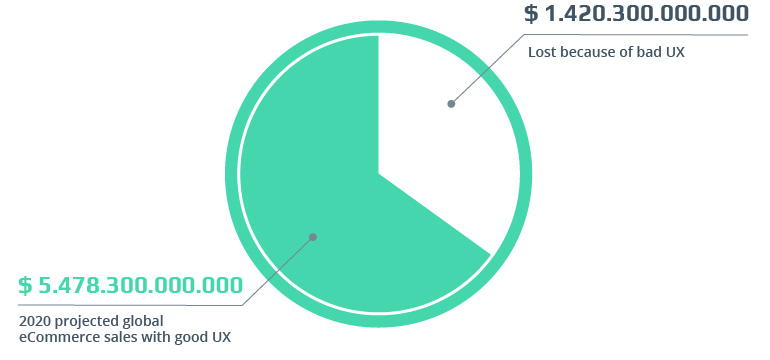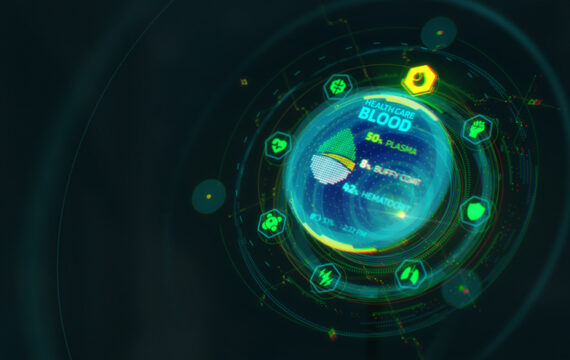To UX or not to UX?
Actually, it’s not even a question anymore, since UX research is a low-cost way to prevent an expensive cure.
According to Amazon’s whitepaper titled The Trillion Dollar UX Problem, there are $1.42 trillion in annual losses in the eCommerce segment due to UX research issues alone. And it’s not like Amazon had to sweat much to arrive at this jaw-dropping figure. They just took e-Marketer’s estimate of $4 trillion in global ecommerce sales in 2020 and multiplied it by the Baymard Institute’s estimate of the underlying possibility to improve sales by 35% with proper UX design in the retail segment.
The math makes sense, doesn’t it?
The numbers presented should make any sensible product owner reach for their phone to shoot off an email with an RFP for user experience services. But before you do that, let’s consider even more empirical insights on UX research services, ROI, and preventive benefits of this fundamental practice.
UX impact on eCommerce in 2020

Source: Amazon — The Trillion Dollar UX Problem
Naturally, this topic is rather broad and impacts different phases of product or service development. With 12 years working in user experience design and an array of Fortune 500 companies in my portfolio, I have cherry-picked the most pertinent information for this piece.
So let’s make a deal: if you like this article and have some questions or would like clarifications on any of the UX research services or methods, leave a message and I’ll share more ideas and techniques.
In my tenure as the head of the Design Office at Intellias, I’ve come to view UX design as a preventive measure.
And you know what they say: prevention is better than a cure. Just like an apple a day keeps a doctor away.

That’s a rather accurate and descriptive metaphor for the impact of UX and UX design research. In simple English, you can totally ignore this stage of product development, but if you pay proper attention to it, you’ll save yourself a lot of hassle later.
Prevention is cheaper, consumes less time and effort, and involves fewer risks than any cure. This also describes product development with the proper UX phase.
Let’s say you can brush and floss your teeth regularly and use an irrigator to prevent cavities. The alternative is to face a problem when it arises — which it inevitably does — and rush to get expensive emergency dental treatment when your canines get inflamed.
The naked truth about user experience stats: The development phase with the highest ROI
Here are some facts to give you a quick perspective on why every software development project needs to devote time and money to UX design research or face the consequences:
- Fixing an error after development is 100 times more costly than fixing it before development.
- 3 of the 12 most cited reasons why projects fail lie in the realm of user experience failures.
- According to Forrester Research, every dollar spent on UX brings an ROI of $100.
- Projects with user personas have 4 times the ROI of those without them.
Now that the why is out of the way, let’s get down to the how.
Asking the right questions to shape the right product
Simple fact: to make the right decisions, we need sufficient inputs.
Most poor decisions are made due to insufficient initial data. The resulting mistakes vary in price from dirt cheap to mind-blowingly expensive.
But they’re never free.
Without relevant information, we rely on our personal assumptions and limited experiences to walk the beaten path of trial and error.

When you need to buy milk, you may ask yourself various questions: How much do I need: a liter, a gallon, or a pint? Should I get 2.5%, skim, or lactose-free? To make the right choice, you must understand the purpose of this purchase: Why do you need the milk and what will you do with it? Drink it as is, add it to tea or coffee, use it in baking? Who will consume it? You, your family, or guests? Do you need to consider lactose intolerance and allergies?
Perhaps you can do little things without a purpose, but more often we must imagine the bigger picture to understand the impact of our actions and make the right choices.
The same applies to business and product development: the more we know, the more precise the actions we can take. And vice versa: the less we know, the higher the risk of harm to the client’s business and our reputation.
At the Intellias Design Office, we apply the 1:10:100 rule that was formulated by Clare-Marie Karat, a principal UX consultant and former IBM researcher: A rule of thumb is for every one dollar invested in User Experience research you save $10 in development and $100 in post-release maintenance.
How does this rule work? For example, say we conduct problem research that lasts several days and costs $1000. That investment allows us to collect information and define scenarios that help define a scope of work and reduce development cycles by avoiding the development of unnecessary features.
How much time does a team of developers need to produce a feature or a set of features?
A day, a week, maybe months? Will it cost another $1K or $10K?
What if users don’t really need the feature(s)? How can we know this without research? What if the product goes to market and the team finds out that nobody uses whole parts of the product or that the product is used for questionable purposes? Will the client lose $1K, $10K, or $100K?
Minimizing risks: Discovering business and user needs
What can we do to minimize the risk of developing the wrong solutions? Get as much information as possible for further analysis and synthesis.
To start, talk to the business owner to understand their goals, vision, and core needs. My personal recommendation is to talk as often as possible with as many stakeholders as possible from the project’s kick-off stage to full closure. In this manner, you’ll have insights coming in at every stage of the process that allow you to fine-tune and introduce corrective measures on the go before the project goes into production.
Tip 1: Be curious, ask, double-check, specify, communicate — nothing good can be created in isolation.
If we’re talking about a product or a service where end users are humans, then we must talk to them; why would we develop anything for people and ignore them? Would you buy a new house or a vehicle that was built without consideration of the users’ needs and experiences?
It’s naïve to think that a business knows everything. It’s even more naïve to assume that you don’t have the budget and time to go talking to the people for whom you’re developing your product.
Many product owners think it’s a waste of time to ask people what they need — and in some cases, not asking also works! But in my experience, it works in the rare exception of visionary entrepreneurs.
We can’t ask people what they need, because they simply need faster horses.
Tip 2: Don’t expect that people will provide extended answers that you can copy and paste into your report just based on the questions “What do you need from a product?” or “What do you lack in the existing product offerings?” Finding actionable insights is on you, and they’re always hidden between the lines.
Questions like the ones below usually yield the most fruitful observations that can be translated into actionable product layouts and steps:
- What are your goals?
- What do you want to achieve?
- What do you do right now to get the expected result?
- Why do you need to do all this?
- What pains, fears, and frustrations do you have?
- What stops you from…?
- What pushes, motivates, and inspires you?
Answers to such questions lead us to innovative solutions that aren’t limited to existing market offerings that the business or users might have on their radar.
Communicating with both sides (the business and users) before defining a solution allows us to create products and services that satisfy goals and meet real needs yet touch the heart, inspire, and evoke joy.
Selecting the most pertinent UX research methods for your project
There are dozens of research methods that UX research companies can use. All of them allow us to get specific results and provide a different level of impact on further development.
For example, in the early stages of planning and research, you can use:
- Desk research
- Ethnographic research
- Participant observations
- Contextual interviews
- Co-creative workshops, etc.
For analysis of collected data and sensemaking, we often use the following arsenal:
- Research wall
- Personas
- Journey mapping
- Jobs-to-be-done insights
- User stories
- Research reports
Here are even more popular UX design research methods for you to get a feeling of what you can use.
In conclusion
The value of UX is not wasting time and money developing the wrong solution.
UX research companies are deservedly gaining more attention from business owners every year. The previously overlooked UX design step of product development has proven its worth and differentiated many industry leaders.
No sustainable or competitive product can be developed in the vacuum of the product owner’s perception. This is especially true when we’re trying to address the problems of people to whom we have no direct access from the very beginning.
The more accurate and market-tested a decision we aim to arrive at, the more resources we need to use to get actionable results. Thanks to a human-centered design approach, there’s a wide array of methods to collect enough information, frame problems, and look at them from multiple perspectives to provide solutions that benefit users and the business as a result.
If you’d like to get more information on user research services, don’t hesitate to ask questions and comment on this article.


